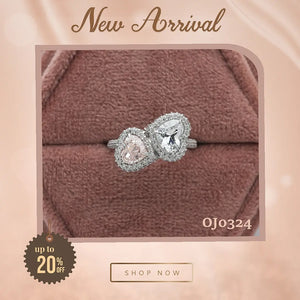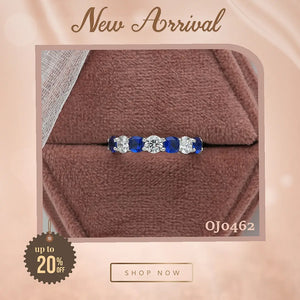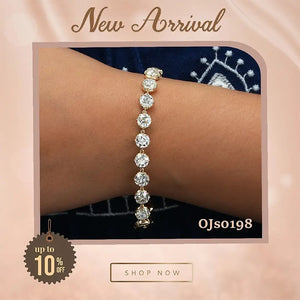What is the average price of an engagement ring?
![[How much should engagement ring cost guide banner]-[Ouros jewels]](https://cdn.shopify.com/s/files/1/0527/7669/8040/files/How_Much_Should_Engagement_Ring_Cost_Webp_2_1024x1024.webp?v=1709104459)
"How much should you spend on an engagement ring?" has always intrigued me. It's one of those things that your grandfather or father may have said, handing along an old family tradition. Is that advice still applicable now, though? Let's explore the origins of this custom and the reasons it has endured for so long.
Table of contents
How Much Should an Engagement Ring Cost?
The question of how much to spend on an engagement ring is one steeped in tradition and family heritage. It's common for older generations, like your father or grandfather, to offer guidance on this significant investment, emphasizing its value.
The type of diamond and setting you choose can have an important effect on the average price of an engagement ring.
The choice of diamond and setting significantly influences the average cost of an engagement ring. The traditional advice for buying an engagement ring suggests allocating an amount equal to one to two months of your income. For example, with an annual salary of $24,000, it's recommended to budget between $3,000 and $6,000 for the ring. Similarly, for someone earning $50,000 a year, a spending range of $6,000 to $10,000 is advised. For those earning a higher income, such as $100,000 annually, a budget of $12,000 to $18,000 is suggested.
![[how much should engagement ring cost, avrage price chart]-[ouros jewels]](https://cdn.shopify.com/s/files/1/0527/7669/8040/files/How_Much_Shoud_You_Spend_On_An_Engagement_Ring_1024x1024.png?v=1709104754)
Exploring options like Lab Grown Diamonds can lead to considerable savings without sacrificing beauty or quality. For example, Ouros Jewels offers stunning 1-2ct center lab-grown diamonds for about $1,500, with solitaire settings priced between $250 and $500. A stunning 4-5ct lab-grown diamond from the same retailer may cost around $5,000, depending on the specific 4Cs (cut, color, clarity, and carat weight). This highlights the diverse range of prices available, shaped by the type of diamond and setting selected.
What is the 4C’s?
The term "4Cs" relates to the four fundamental characteristics that are used to assess and characterize a diamond's quality. The Gemological Institute of America (GIA) created these generally accepted standards. The 4Cs consist of:
1. Diamond Carat Weight:
![[4Cs of Diamond guide carat weight chart]-[ouros jewels]](https://cdn.shopify.com/s/files/1/0527/7669/8040/files/Carat_Chart_1_480x480.png?v=1709108316)
A diamond's weight is indicated by its carat weight. Exactly one-fifth of a 200 milligrams is equal to one carat. The carat weight of a well-cut diamond determines its size, and bigger diamonds are typically more costly.
Our guide will help you find the ideal diamond for any size.
0.25–0.50 carat: Ideal for minimizing flaws. Focus on cut and color, selecting Very Good or Ideal cuts for brilliance.
0.75 - 1 Carat: Still conceals faults. Select SI1 or SI2 clarity and prioritize. Cuts for sparkling are very good or ideal.
1.25-1.5 carats: Cut and clarity take precedence. Try for VS2 clarity or above for a perfect look.
2-4 Carat: Look for eye-clean diamonds with at least VS1 clarity for a stunning show.
5 And More Carat: Each detail counts. For unparalleled elegance, select diamonds with excellent cut, symmetry, and polish.
2. Diamond Cut:
![[4Cs of Diamond cut grade chart with its five types: Excellent, Very Good, Good, Fair, and Poor. Consider selecting a perfect cut grade according to the diamond shape and jewelry style.]-[ouros jewels]](https://cdn.shopify.com/s/files/1/0527/7669/8040/files/Cut_Chart_1_480x480.png?v=1709108825)
How a diamond's facets interact with light is referred to as its cut. It assesses the sparkle and brilliance of the diamond and often assigns a grade that ranges from "Excellent" to "Poor."
Ideal/Excellent Cut diamonds: These diamonds are precision-cut to increase light reflection and offer unmatched sparkle and beauty. Experience amazing brilliance and clarity in all aspects. Perfect for those seeking the heights of diamond beauty.
Good/Deep Cut Diamonds: Experience sparkling brilliance and depth. These diamonds have a stunning shine, balanced symmetry, and impressive polish, making them an excellent choice for people looking for quality and value.
Poor Cut Diamonds: These diamonds lack sparkle and symmetry, resulting in a dull look with uneven surfaces. Ideal for individuals on a small budget who still want the diamond feel.
3. Diamond Color:
![[4Cs of Diamond color grade chart describing the colorless, nearly colorless, faint yellow, very light yellow, and light yellow range for making a decision on which to choose for jewelry]-[ouros jewels]](https://cdn.shopify.com/s/files/1/0527/7669/8040/files/Color_Chart_480x480.png?v=1709109186)
A pure diamond has no imperfections or blemishes and is colorless. The diamond has undesired yellow or brown tones due to impurities like nitrogen. color is rated on a scale of letters from D to Z.
D-F Colorless Diamonds: These diamonds are the purest and most valuable since they are practically colorless. F grades may have minimal color, visible only to experts.
G-J Near Colorless: These diamonds look clear at first glance, but they may disclose minor colors from below.
K-M Faint Color Diamonds: Ideal for budget-conscious fans seeking a touch of color. These jewels have delicate hues that add to their specific charm.
N-R Very Light Yellow Diamonds: Discover the charm of very light yellow diamonds, which provide delicate beauty and fire at an affordable price. Ideal for adding a splash of color without breaking the bank.
S-Z Light Yellow Diamonds: Enhance your collection with light yellow diamonds, which are noted for their brilliant color and great value. Ideal for people wanting colorful brilliance.
4. Diamond Clarity:
![[4Cs of Diamond clarity grade chart from Internally Flawless to Included 3 range to see the difference with other types and purchase decisions for perfect clarity.]-[ouros jewels]](https://cdn.shopify.com/s/files/1/0527/7669/8040/files/Clarity_Chart_480x480.png?v=1709109404)
According to the Gemological Institute of America (GIA), clarity evaluates when a diamond has internal (inclusions) or external (blemishes) defects. The assessment covers diamonds that are perfect and show no obvious problems, even at 10x magnification, to diamonds that have inclusions and/or imperfections that are evident to the naked eye.
Internally Flawless (IF): Under magnification, there are no discernible defects, resulting in a nearly flawless look. Ideal for those seeking unparalleled purity in their lab grown diamond.
Very Very Slightly Included (VVS1,VVS2): These diamonds are flawless to the naked view and appear perfect. Only little inclusions may be visible under magnification, demonstrating their outstanding quality.
Very Slightly Included (VS1,VS2): Find diamonds with minor inclusions that are only visible under close inspection. Ideal for individuals looking for near-perfect jewels at a fantastic price.
Slightly Included (SI1,SI2,SI3): Little flaws and inclusions are clear to the naked eye.
Included (I1,I2,I3): Visible flaws and inclusions are easily detected with the naked eye.
How much spend on engagement ring?
Your budget for an Engagement Ring is a personal choice. Stay clear of marketing tricks that encourage excessive spending. The idea of investing two or three months' pay is a marketing ruse so forget about it. For the ring you like, instead, pay attention to your finances.
It's exciting to get ready for your proposal, and having a stunning ring is a must. It represents your commitment to one another and your feelings for one another. In case you're thinking, "How much should I spend on an engagement ring?" this article offers valuable advice.
![[Image showing a variety of engagement rings with different price tags, illustrating the concept of budgeting for an engagement ring purchase.]-[ouros jewels]](https://cdn.shopify.com/s/files/1/0527/7669/8040/files/How_Much_you_Spend_on_an_Engagement_Ring_is_Completely_up_to_you_1024x1024.png?v=1709110050)
While the exact average cost of engagement rings remains elusive, surveys among buyers typically reveal an average spending range between $4,000 and $8,000. However, it's crucial to note that this does not imply a necessity to spend $5,000 or more. The higher average is skewed by individuals who choose to invest $10,000 or more in their rings.
According to a survey by Morning Consult, as reported by the New York Times, the average price of an engagement ring is around $1,900. Our curated collection survey stunning engagement rings priced at $3,000 and below, reflecting a preference among many couples to spend less than $4,000 on their lab-grown diamond engagement rings.
Furthermore, spending habits on engagement rings significantly differ across generations. Millennials, for instance, tend to spend an average of $2,500, despite the general average exceeding $4,000.
Benefits of lab grown diamond engagement ring?
![[Image showcasing the sparkle and elegance of a lab-grown diamond engagement ring benefits , highlighting its ethical, affordable, and high-quality advantages]-[ouros jewels]](https://cdn.shopify.com/s/files/1/0527/7669/8040/files/Ring_Banner_1024x1024.png?v=1709110550)
The adage now suggests that a lab-grown diamond is a girl's new best friend. Despite some traditionalists' reservations, the jewelry world is rapidly recognizing lab-grown diamonds as the modern emblem of eternal love. These diamonds, created in laboratories through processes that mimic the natural formation of diamonds, are chemically identical to those mined from the earth.
We highlight the advantages of lab-grown diamonds in this article to give you peace of mind when selecting one for your Wedding ring.
1. Similar look as mined diaonds:
Lab-grown diamonds boast the same optical, chemical, and physical properties as their mined counterparts, ensuring the same brightness and sparkle. An engagement ring adorned with a lab-grown diamond offers the timeless elegance and feel of a real diamond.
2. Cost-Effective:
Lab-grown diamonds provide a more budget-friendly option for your engagement ring, being 40% to 70% less expensive than mined diamonds. This price advantage means you can opt for a larger stone or a higher quality diamond for the same investment.
3. Better Quality:
The controlled environment in which lab-grown diamonds are created allows for fewer inclusions and flaws, resulting in diamonds of greater purity and perfection. Consequently, a lab-grown diamond may exhibit even more brilliance than a naturally mined one.
4. Ethical Choice:
Buying for a lab-grown diamond engagement ring means choosing ethically sourced jewelry. Produced under stringent and humane conditions, these diamonds eliminate concerns related to "blood diamonds" or labor exploitation in the diamond mining industry.
5. Wide Range of Options:
The production process of lab-grown diamonds allows for a broader selection of colors and grades, previously limited by the high cost of certain mined diamonds. This advantage opens up an expansive range of choices for consumers.
5. Wide Range of Options:
Lab-grown diamonds are available in a diverse palette of colors, offering more options than naturally colored diamonds, which are rare and expensive. This accessibility to a variety of hues allows customers more freedom to personalize their diamond jewelry creatively.
Conclusion
In today's modern landscape, the age-old debate over how much to spend on an engagement ring is experiencing a significant shift. Traditional notions tied to monthly wages are giving way to more personalized budgeting strategies. Many couples are now gravitating towards more affordable options, particularly those featuring lab-grown diamonds.
Lab-grown diamonds offer the same impeccable qualities as mined diamonds but at a more affordable price point. They boast higher quality, ethical sourcing, and a diverse selection, making them an attractive choice for conscientious consumers. As a result, the engagement ring market is evolving to prioritize individual style preferences, financial responsibility, and the embrace of innovative and ethical alternatives. Whether opting for a Anique Cut Engagement Ring crafted from natural or lab-grown diamonds, couples symbolize unwavering commitment and love in today's modern setting.
"Should you want further details on lab-grown diamonds and how much to spend on engagement rings? Send us an inquiry if you have questions."
FAQs
Q.1 What is the average price of an engagement ring
Ans.The average cost of a lab-grown diamond ring falls within the range of $1,500 to $4,000. real diamonds, due to their rarity and uniqueness, can cost between $5,000 and $16,000 for a one-carat ring. Factors such as color, carat weight, clarity, cut, metal, choice of diamond type, and ring settings all influence the price of a diamond ring.
Q.2 How much should I spend on an engagement ring?
Ans. Many people agree that traditional advice on engagement ring spending is outdated. It's recommended to spend within your means, with a common suggestion being no more than two months' worth of pay on an engagement ring. find the perfect ring within your budget at OUROS JEWELS.
Q.3 Three Month Salary Rule for Engagement Rings?
Ans. The notion of spending three months' salary on an engagement ring stems from a historic advertising campaign in the 1930s. It implied that true love and commitment were demonstrated by investing an entire month's income into an engagement ring.
Q.4 What impact do the 4Cs have on an engagement ring's cost?
Ans. The price of a diamond ring is significantly influenced by its 4Cs: carat, cut, color, and clarity. A higher carat weight, better cut, nearly colorless look, and fewer inclusions (greater clarity) all reflect to a higher price.
Q.5 Can a customized engagement ring be more affordable?
Ans. Custom engagement rings may require additional effort and feature unique designs, potentially resulting in higher costs. However, at OUROS JEWELS, we offer the flexibility to select specific stones and materials within your budget, making customization a viable and affordable option.
Recent Posts
-
What Is Diamond Carat: Size Chart and Price
May 1, 2024 -
Diamond Cut: Cut Grading & Quality and Buying Guide
April 30, 2024 -
Every Month's Birthstone FAQs – Your Gemstone Guide
April 22, 2024 -
October Birthstone: Quick Guide to Opal and Tourmaline
April 22, 2024 -
Exploring the Ruby Gemstone: July Birthstone
April 19, 2024 -
The Attraction of May Birthstone - Emerald
April 18, 2024 -
Beautiful Yellow Gold Engagement Rings
April 17, 2024 -
1 Carat Brilliant Cut Diamonds and Rings
April 15, 2024 -
Explore the Natural Beauty of March Birthstone: Aquamarine
April 13, 2024
![[Ouros Jewels Officla Logo]](http://www.ourosjewels.com/cdn/shop/files/Ouros_Logo_Cap-02_e8b5c4d5-7168-48f6-aa08-6f82bb5c7397_480x200.png?v=1672033260)
 Brilliant Cut Rings
Brilliant Cut Rings
 Old Cut Rings
Old Cut Rings
 Colored Diamond Ring
Colored Diamond Ring
 Antique Diamond Ring
Antique Diamond Ring
 Salt & Pepper Ring
Salt & Pepper Ring
 Solitaire Rings
Solitaire Rings
 Halo Ring
Halo Ring
 Bridal Set
Bridal Set
 Solitaire Accent
Solitaire Accent
 Three Stone Ring
Three Stone Ring
 Semi Mount Ring
Semi Mount Ring
 Bezel Set
Bezel Set
 Pave Set
Pave Set
 Eternity Band
Eternity Band
 Channel Set
Channel Set
 Dainty Rings
Dainty Rings
 Toi Moi Rings
Toi Moi Rings


 Colored Diamond
Colored Diamond
 Old Cut Diamond
Old Cut Diamond
 Antique Shapes
Antique Shapes
 Diamond Layout
Diamond Layout
 Brilliant Cut
Brilliant Cut
 Certified Stone
Certified Stone
 Matching Pairs
Matching Pairs
 Gemstones
Gemstones
 Best Sellers
Best Sellers
 New Arrivals
New Arrivals


 Studs
Studs
 Drop & Dangle
Drop & Dangle
 Hoop Earrings
Hoop Earrings
 Pendants
Pendants
 Necklaces
Necklaces
 Birthday Special
Birthday Special
 Anniversary Special
Anniversary Special
 Bracelets
Bracelets
 Bangles
Bangles
 Chain
Chain
 Ring
Ring
 Bracelet
Bracelet
 100-299$
100-299$
 300-499$
300-499$
 500$ and More
500$ and More

![[Ouros Jewels Officla Logo]](http://www.ourosjewels.com/cdn/shop/files/Ouros_Logo_Cap-02_e8b5c4d5-7168-48f6-aa08-6f82bb5c7397_5001x2084.png?v=1672033260)
![[Diamond Carat Size Chart and Price]-[ourps jewels]](http://www.ourosjewels.com/cdn/shop/articles/Diamond_Carat_Size_Chart_and_Price_small.webp?v=1714623776)
![[Diamond Cut: Cut Grading & Quality and Buying Guide]-[ouros jewels]](http://www.ourosjewels.com/cdn/shop/articles/Understanding_Diamond_Cut_Main_Banner_73.1_KB_small.webp?v=1714465413)
![[Every Months Birthstone FAQs New]-[ouros jewels]](http://www.ourosjewels.com/cdn/shop/articles/1_Every_Months_Birthstone_FAQs_New_small.webp?v=1713791642)
![[Explore the Magic of October Birthstones Opal and Tourmaline]-[ouros jewels]](http://www.ourosjewels.com/cdn/shop/articles/1_Explore_the_Magic_of_October_Birthstones_Opal_and_Tourmaline_small.webp?v=1713615720)
![[Exploring the Ruby Gemstone: July Birthstone]-[ouros jewels]](http://www.ourosjewels.com/cdn/shop/articles/1_Exploring_the_Ruby_Gemstone_July_Birthstone_small.webp?v=1713523601)
![[April Birthstone Guide: Unlock the Beauty & History of Diamonds]-[ouros jewels]](http://www.ourosjewels.com/cdn/shop/articles/April_Birthstone_Guide_Unlock_the_Beauty_History_of_Diamonds_small.webp?v=1713505430)
![[The Attraction of May Birthstone - Emerald]-[ouros jewels]](http://www.ourosjewels.com/cdn/shop/articles/1_The_Attraction_of_May_Birthstone_Emerald_small.webp?v=1713419365)
![[Beautiful Yellow Gold Engagement Rings]-[ouros jewels]](http://www.ourosjewels.com/cdn/shop/articles/Beautiful_Yellow_Gold_Engagement_Rings_small.webp?v=1713336405)
![[wegging ring buying guide]](http://www.ourosjewels.com/cdn/shop/articles/1_Wedding_Ring_Buying_Guide_small.webp?v=1713326659)
![[1 carat brilliant cut diamond rings for engagement]-[ouros jewels]](http://www.ourosjewels.com/cdn/shop/articles/1_Carat_Brilliant_Cut_Diamonds_and_Rings_small.webp?v=1713248098)
![[March Birthstone: Aquamarine]-[ouros jewels]](http://www.ourosjewels.com/cdn/shop/articles/1_March_Birthstone_Aquamarine_small.webp?v=1713010479)